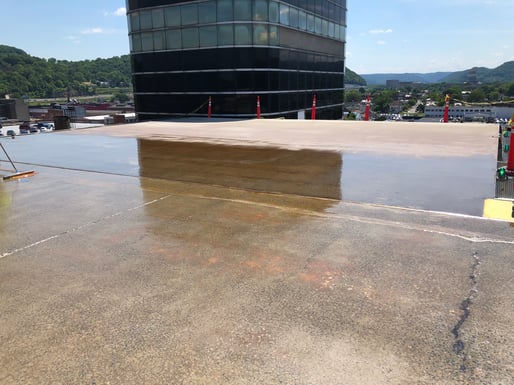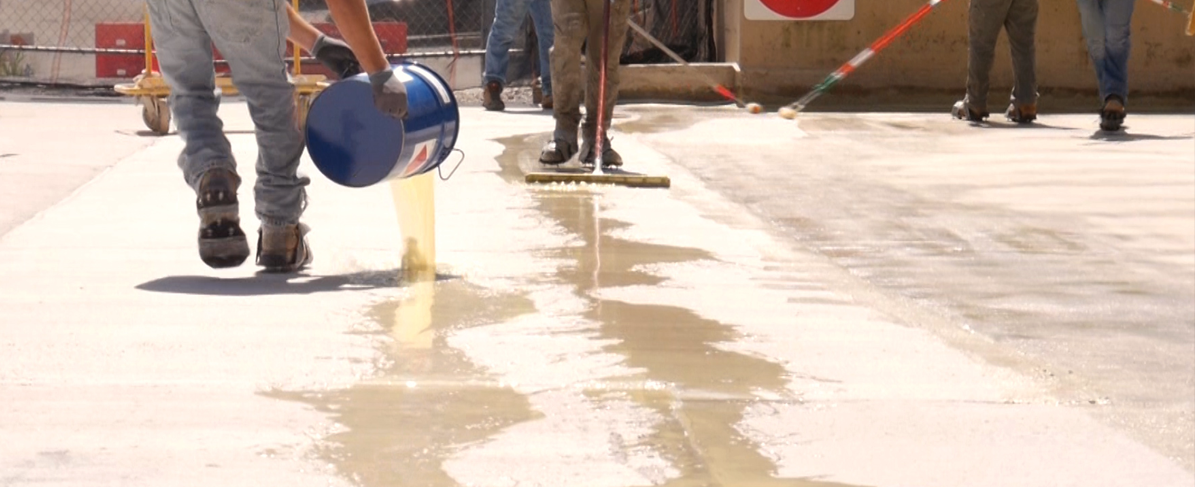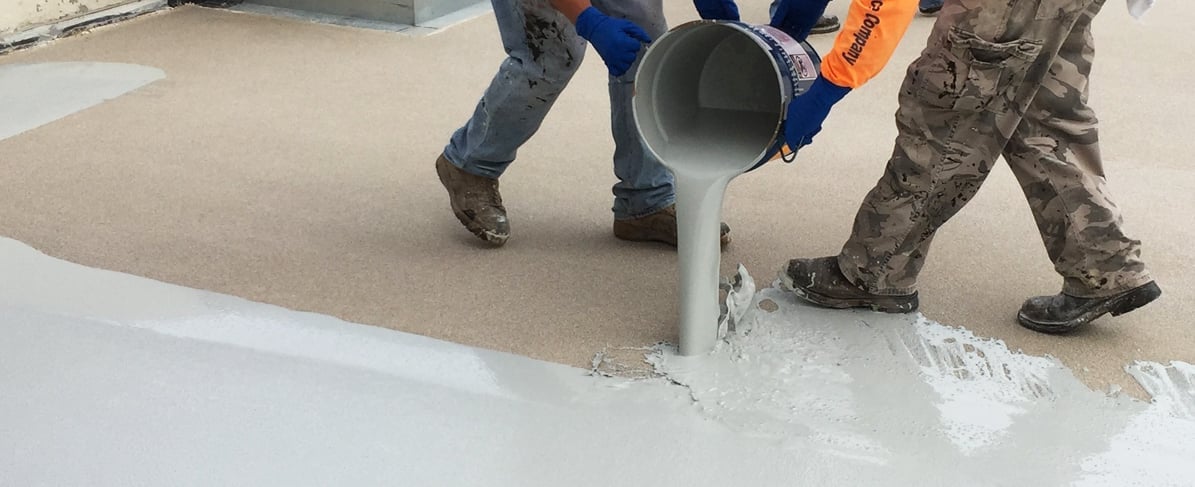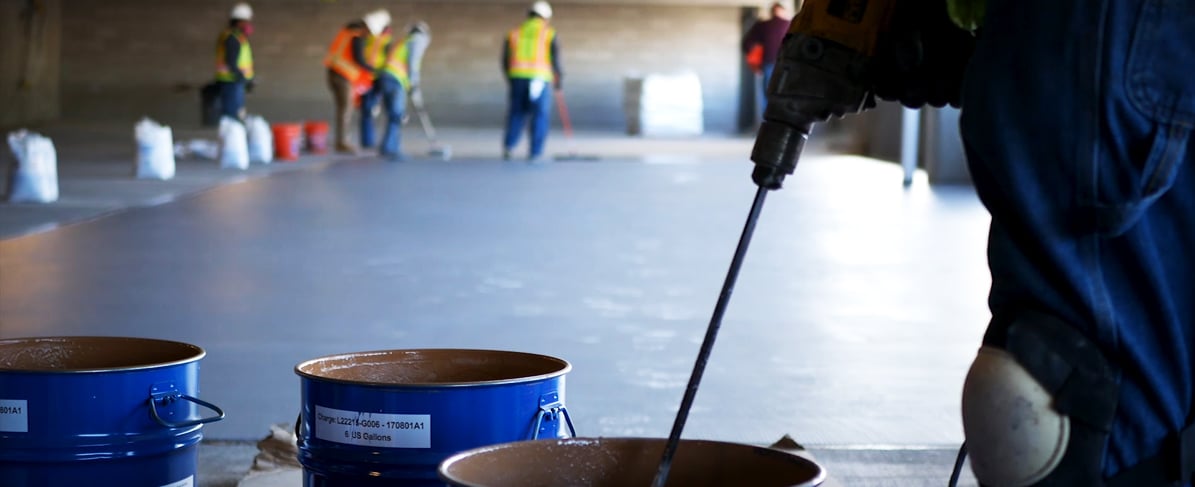Choosing the right primer for a traffic coating system requires understanding the materials, environment, traffic levels and substrate conditions. The two most common primers for traffic coating systems are epoxy primers and urethane primers. Each offers its own set of benefits for the application.
Coating systems protect the substrate from wear, corrosion, impact, weathering and abrasion, so proper product selection and application is vital to the longevity of the substrate and the waterproofing system. Selecting the suitable primer is an essential step in a coating system because the effectiveness of all subsequent coatings depends on a strong initial bond to the substrate. If the primer isn’t effective, then the consequences can vary from delamination to blistering or contamination of waterproofing.
A traffic coating system can include a primer, base coat, intermediate coat and top coat, although not every system will require all 4 layers. Deciding between an epoxy versus urethane primer comes down to various factors, including the coating system itself, substrate conditions, daily traffic, the specific facility, location and environmental factors like heat and humidity.
Epoxy Primers
 A typical epoxy primer consists of a two-part system that includes a resin and a hardener. When combined, they create a chemical reaction that cures into a very durable surface for the bonding of subsequent layers.
A typical epoxy primer consists of a two-part system that includes a resin and a hardener. When combined, they create a chemical reaction that cures into a very durable surface for the bonding of subsequent layers.
Prior to the epoxy primer application, the substrate must meet manufacturer’s prescribed conditions that likely require mechanical abrasion to reach a specific concrete surface profile. Modifications can even be made to the application method such as applying the epoxy in multiple layers and broadcasting aggregate into the epoxy for a better bonding surface for subsequent layers.
Applying epoxy is generally not difficult because most epoxies have a long enough pot life that the application doesn’t feel rushed. They typically have a higher moisture tolerance in the substrate when compared to urethane primers. Epoxies can be used in applications where there is a concern for vapor drive because of moisture inside or underneath the substrate. Epoxies have a low permeance value that, when combined with the very high bond strength, makes them ideal as a moisture mitigation primer. Epoxies also have a higher chemical resistance and can offer protection from corrosion in the substrate.
Epoxies have many positive attributes that make them a great choice for priming. However, they do come with a few trade-offs. The hard, durable nature of epoxy gives it a low elongation value, so significant movement in the substrate may cause cracking in the epoxy that can propagate through the layers of coating.
The cure time for epoxies can also be a determining factor. Most industry epoxies will take several hours to cure and can be heavily influenced by ambient and substrate temperatures. Colder temperatures will significantly increase the time for an epoxy to fully cure through and it’s important to consider the minimum application temperature for each epoxy. Note that urethane systems can often tolerate lower temperatures than epoxies which may influence your decision making. Finally, the cost of an epoxy can often exceed that of a urethane primer, so be sure to evaluate the application conditions to determine if the additional cost is necessary.
Urethane Primers
 Urethane coating systems often have good adhesion to the substrate and don’t always require a primer for standard applications. When the adhesion is not on par with the expected values then a urethane primer is recommended. An epoxy primer showcases its strength in versatility whereas a urethane primer offers simplicity. A urethane primer is made from compatible chemistry to urethane systems and is typically a single component that uses moisture to cure. Urethane primers are easy to apply by simply rolling onto the substrate and allowing to cure. They are applied very thin and penetrate the concrete pores but will not really change the substrate profile after application. Therefore, the surface profile requirements of the subsequent urethane system still need to be followed prior to the application of the primer.
Urethane coating systems often have good adhesion to the substrate and don’t always require a primer for standard applications. When the adhesion is not on par with the expected values then a urethane primer is recommended. An epoxy primer showcases its strength in versatility whereas a urethane primer offers simplicity. A urethane primer is made from compatible chemistry to urethane systems and is typically a single component that uses moisture to cure. Urethane primers are easy to apply by simply rolling onto the substrate and allowing to cure. They are applied very thin and penetrate the concrete pores but will not really change the substrate profile after application. Therefore, the surface profile requirements of the subsequent urethane system still need to be followed prior to the application of the primer.
In general, urethane primers are not as moisture tolerant as epoxy primers so the substrate must be dry prior to application. The exact limit is determined by the manufacturer. The cure time of urethane primers is often much faster than epoxy primers and have a slightly lower temperature minimum for application. It is possible for a urethane primer to be ready to be coated in 1 to 2 hours. However, this faster cure time comes with a window of opportunity to apply the next coating. If that window is missed, then the primer that was applied must be cleaned and reprimed to be able to accept the next layer of coating. The similar chemistry of a urethane primer offers excellent adhesion properties for subsequent urethane coatings.
Selecting the Right Primer
Selecting the correct primer for a traffic coating system depends on several factors, including where it will be applied, the degree of traffic, and environmental factors.
Ultimately, understanding the unique needs of each project is paramount to choosing the right primer, so be sure to evaluate your jobsite conditions, anticipated movement of the structure, and the manufacturer’s recommendations before proceeding.
If you have any further questions, contact our experts at Tremco today for advice on your next project.






